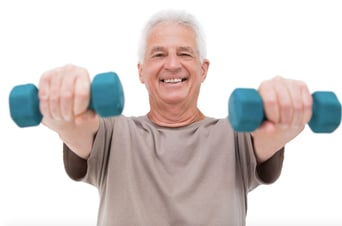Tips for Exercise and Fitness as You Age
Aaron Aslakson, director of fitness centers | Nov 4, 2015
Often times just getting started and making the commitment to a regular exercise and fitness routine is the hardest part. No matter where you are on the fitness spectrum, consult your physician about an exercise program before you begin. Secondly, whether you plan to join a fitness facility or exercise at home, it can beneficial to meet with a fitness professional and complete a fitness assessment. This will give you an idea of your strengths and potential areas for improvement. Finally, make sure you have the proper attire for the type of exercise you will be doing. Pay close attention to your footwear; proper footwear will not only help keep away some aches and pains in the lower body, and is a safety factor for outdoor exercise, such as walking.
Below are a few tips for exercise and fitness that I encourage older adults to keep in mind, and to remind them of the importance of staying active.

Find Fun Exercises
Whether you are staying physically active at home or are a member of a fitness center, there are numerous options to help you reach your fitness goals. Finding exercises you enjoy will help you commit to a regular routine and provide motivation to help reach your goals. If you find yourself feeling bored with the same exercises, try a different form of exercise or a new group class at the fitness center. Finally, make exercise a part of your social calendar. Walking and cycling groups, meeting friends for group exercise classes, or simply meeting a friend at the gym can be a great way to help with motivation and accountability. Looking for an added social benefit? Split the cost of a personal trainer with a friend or family member. Most personal trainers give a discount for a 2 to 1 training session and you get the added social benefit!
Commit to a Routine
The recommendations set forth by many governing fitness organizations can be a bit daunting, but keep in mind you don’t have to achieve it all in one workout. Accumulate your exercise throughout the day, as little as 10 minutes at a time has been shown to have benefits for older adults. However, it is important to commit to a routine. Have an idea what you want to do each day for exercise and what time you will do it. This structured schedule will help you stay focused and prevent you from scrambling last minute for exercises or even skipping a workout. General recommendations for older adults show that you should involve four basic forms of exercises in your regular regimen. They include strength training, cardiovascular training, flexibility training, and balance training. Choose a nice combination of exercise that work on these forms of exercise for overall health and well-being.
Quick Exercise and Fitness Tips
1. Listen to your body as you exercise. Although you may be a bit stiff and sore after exercise, sharp pain or a pain that doesn’t go away should prompt a visit to your care physician.
2. Take time to learn the proper forms of exercise. This is not only a safety tip, but will also help you get proper benefits from exercise. Not sure how do to an exercise? Ask a fitness professional. Don’t assume the person on the machine before you knows the proper form.
3. Challenge yourself to try one new exercise each month. Go into it with an open mind and have fun trying something new, while getting a workout. You may surprise yourself and find a new exercise that becomes a regular part of your routine.
4. Reward yourself. When you meet goals, have a reward in mind. This can be intrinsic or extrinsic and it can be big or small, but reward yourself for achieving your health and fitness goals.

